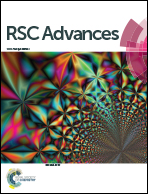Visible-light-drived high photocatalytic activities of Cu/g-C3N4 photocatalysts for hydrogen production
Abstract
Cu/g-C3N4 photocatalysts have been synthesized using a facile method. The composition and morphology of the prepared samples were characterized by a variety of analytical methods. The results indicate that the Cu nanoparticles were uniformly loaded onto the surface of g-C3N4. In addition, photocatalytic activity experiments were carried out by investigating H2 production under visible light irradiation. The results reveal that the composites exhibited excellent performance for H2 evolution in the absence of a cocatalyst, which demonstrates that Cu nanoparticles could trap photogenerated electrons and act as a cocatalyst effectively. Thus, it was effective in transferring the interfacial photogenerated charge carriers and efficiently enhanced the photocatalytic activity.


 Please wait while we load your content...
Please wait while we load your content...